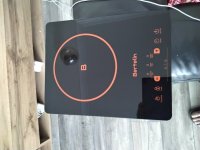When you were at school, did you move bar magnets in and out of a coil of wire to "induce" an electric voltage?
If you do it quicker, the voltage gets higher.
Did you replace the permanent magnet with a powered coil of wire, to act as an electromagnet? Moving it has the same effect, but switching on and off also induces a voltage.
Did you convert it to a transformer, by using the coil as a primary circuit? It only works with alternating current, as that constantly changes the magnetic field.
That is the basis of an induction cooker/hob: your power supply creates an electromagnet which constantly changes in strength and the pan acts as the secondary coil, generating heat as the induced current flows through it.
In maths, did you draw a sine curve? It's a smoothly changing line, a bit like a gentle wave in the sea.
If you have a pure sine wave
inverter then you get a smoothly changing current which induces a smoothly changing current it the pan.
But a modified sine wave is a series of straight lines: straight up then straight down (imagine at 45deg).
Where it changes from going up to going down there is a sudden change in current and that is like moving the magnet quickly: you induce a very large voltage (only for a brief moment, but enough to do damage).
You NEED a pure sine wave
inverter!
Gordon (retired physics teacher)

